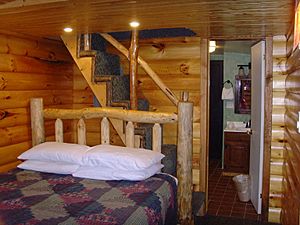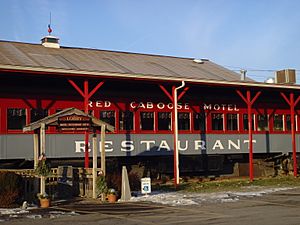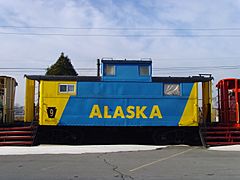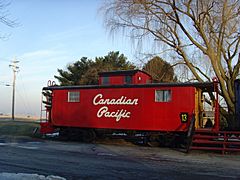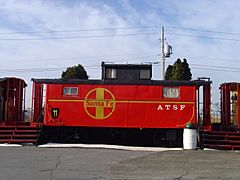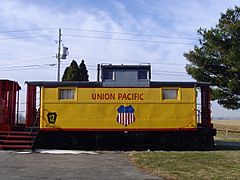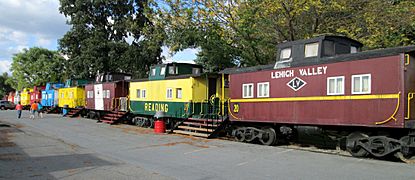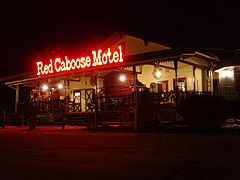Red Caboose Motel facts for kids
| Red Caboose Motel | |
Quick facts for kids  |
|
| Hotel facts and statistics | |
|---|---|
| Location | Ronks, Lancaster County, Pennsylvania |
| Coordinates | 39°59′08″N 76°09′06″W / 39.9855°N 76.1516°W |
| Address | |
| Opening date | May 10, 1970 |
| Developer | Donald M. Denlinger |
| No. of restaurants | 1 |
| No. of rooms | 48 rooms/38 cabooses |
| No. of floors | 1 |
The Red Caboose Motel is a super cool place to stay in Pennsylvania's Amish country. It's near Ronks, and what makes it special is that you get to sleep inside real railroad cabooses!
This motel has more than 35 cabooses and other train cars. Some of these cars are even used as a restaurant. Donald M. Denlinger created and opened the motel in 1970. He started by buying 19 extra cabooses from a railroad auction.
Since then, the motel has grown and been updated. Besides offering unique rooms, the Red Caboose Motel has hosted many train-themed events. It's also close to other fun train places, like the Railroad Museum of Pennsylvania. The Strasburg Rail Road, a very old train line, runs right past the motel! The Red Caboose Motel is known as a famous landmark and a fun place to visit. In 1984, it was even listed in the Guinness World Records for having the most privately owned cabooses in the world.
Contents
How It All Started
The idea for the Red Caboose Motel began in the summer of 1969. Donald M. Denlinger, a developer from Pennsylvania, decided to bid on 19 cabooses. These cabooses were being sold at an auction by the Penn Central Railroad.
Denlinger was known for creating other fun tourist spots in the area. He bid $700 for each caboose. This was actually less than what the metal was worth as scrap!
There's a famous story about how Denlinger bought the cabooses. It's said he made the bid almost as a joke or a dare. He supposedly didn't even plan to win or use them for a motel. The story goes that he forgot about the auction until January 1970. Then, the railroad called him, saying he was the highest bidder! They told him he had to pick up the cabooses that very day.
However, a newspaper article from January 1970 tells a slightly different story. It says Denlinger was inspired in 1969 when he saw a caboose being used as a tourist center. He then learned about the 19 cabooses for sale. This article says he knew his bid was accepted and planned to get the cabooses.
On January 4, 1970, the railroad called again. They said ten cabooses and a coach car had been moved. He needed to pick them up right away because the tracks were needed. Denlinger then had to quickly find a temporary place to store the cars. He found an unused track in Gordonville, and the railroad let him use it.
The article also says that Denlinger had already picked out the land in Ronks. He had also gotten a bank loan and chosen the name "Red Caboose Lodge." This suggests he had a plan all along!
Denlinger needed a big piece of land next to a railroad track for his motel idea. Many good spots were owned by Amish people, who wouldn't rent land for a business like a motel. He finally found a 43-acre farm for sale in Ronks. It was about 8 miles east of Lancaster and right next to the Strasburg Rail Road. He leased the farm for a year with an option to buy it later.
Getting money for the project was a challenge. A bank in Lancaster was interested in his unique idea. After hearing his story, they decided to give him a loan of $185,000.
Work on the motel began in January 1970. They laid 800 feet of track for the train cars to sit on. The Strasburg Rail Road allowed a temporary connection to their tracks for delivery. On February 27, 1970, the first ten cabooses arrived. They were pulled by Strasburg Rail Road's old Steam Locomotive #31. The goal was to have the motel ready for guests by Mother's Day, May 10, 1970.
What the Motel is Like
The Red Caboose Motel has 38 cabooses, a railway post office car, and a baggage car. There's also an old farmhouse and barn. Two dining cars serve as the restaurant, with a boxcar in between for the kitchen. All the train cars sit on real railroad tracks. The tracks are laid out in short sections to make the motel compact. The cars are welded to the tracks, so they can't move.
Inside, the cabooses were made cozy. They added insulation over the steel walls. Some rooms had two double beds for four people. Others slept six with one double bed and four bunk beds. The caboose's top section, called a cupola, was used to hide the air conditioner. Electric heaters and a bathroom with a shower were also put in each caboose.
The first caboose rooms had a fun detail: a fake potbelly stove! Inside the stove was a black and white TV, and a lamp hung from the stovepipe. Each caboose has a bathroom in the middle. The rooms are all unique with different wall designs. They had to find or make small furniture to fit inside the cars. Some pieces were made by a local cabinetmaker.
The builders didn't realize the cabooses had three-inch-thick concrete floors. This made drilling holes for plumbing and wiring much harder than expected!
Today, there are nine different room layouts. Some have four or six bunk beds. One caboose is even a "honeymoon suite" with a Jacuzzi!
When the motel first opened in 1970, all the cabooses were painted bright red. This was a traditional color for cabooses. Later, they were repainted in the colors of different famous American or Canadian railroads.
On opening day in May 1970, 4,500 people came to see the motel! Back then, it only had ten cabooses and one dining car that served breakfast. So many people wanted to look inside a room that in 1972, they added one caboose just for tours. By 1973, 81,000 people had toured that one caboose!
Two old Pennsylvania Railroad passenger cars from the 1920s were brought to the motel. They were turned into a restaurant. The restaurant, now called Casey Jones’ Restaurant, opened in June 1974. Each car could seat about 120 people. They even had a special system to gently rock the cars, making it feel like you were moving on a train!
By 1973, the caboose rooms were so popular that they were booked three weeks in advance during the busy summer. In the 1980s, more cabooses, a post office car, and a baggage car were added. The original farmhouse on the property is also used for extra rooms.
Over the years, the Red Caboose Motel has hosted many events. These include auctions for railroad items and weekly shows in the barn. In 1980, they even had a reenactment of a famous train race! A steam locomotive raced against a historic stagecoach.
As of 2018, guests could enjoy a miniature train ride, a petting zoo, and free movies in the barn. Casey Jones’ Restaurant serves classic American food, like what you might find on old trains. You can also see steam trains from the nearby Strasburg Rail Road pass by while you eat. The motel and restaurant close for January and February each year.
Train Museum
In 1972, Donald Denlinger added a Pullman passenger car. He turned it into a museum for railroad items called The Age of Steam Museum. He bought many items from a collector in Texas. With his own collection, it might have been the largest private collection of steam-era railroad items.
The museum showed off 170 steam whistles! They ranged in size from 4 inches to nearly 6 feet tall. There were also railroad bells, the largest weighing 300 pounds. The collection included railroad crossing signs, old train logos, and engine plates. There was even a pretend station master's office.
Who Owned the Motel
Donald Denlinger, the founder, retired in 1993 after 22 years. He sold the motel for $1.7 million. Over the years, the motel changed owners a few times.
In 2003, the motel faced some problems and had to close for a short time. It was then sold to Dan and Judy Mowery. Later, a bank took over the property.
In 2005, a new owner named Larry DeMarco bought the motel. He planned to spend $2 million to buy the property and fix it up. He talked with Donald Denlinger, the original owner, for advice. DeMarco updated many of the rooms and the kitchen. He reopened the motel in 2005.
In 2016, DeMarco sold the property for $1.7 million. The new owners had not run a hotel before. They got help from a U.S. Small Business Administration loan. They immediately started about $75,000 worth of renovations.
Famous Appearances
The Red Caboose Motel has been called "world famous." It has been featured in many popular magazines like National Geographic, Reader's Digest, and Ripley's Believe It or Not!.
As mentioned before, it was listed in Guinness World Records in 1984. This was for having the largest collection of privately owned cabooses in the world.
Gallery
Images for kids


